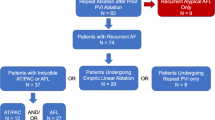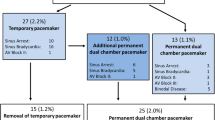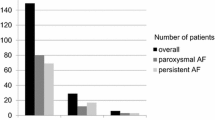Abstract
Background
Adverse structural and electrical remodeling underlie persistent atrial fibrillation (PersAF). Restoration of sinus rhythm (SR) prior to ablation in PersAF may improve the underlying substrate, thus improving arrhythmia outcomes. The aim of this study was to evaluate if the presence of SR at time of ablation is associated with improved long-term arrhythmia outcomes of a limited catheter ablation (CA) strategy in PersAF.
Methods
Patients with PersAF undergoing pulmonary vein isolation at our institution from 2014–2018 were included. We compared patients who presented for ablation in SR (by cardioversion and/or antiarrhythmic drugs [AADs]) to those who presented in AF. Primary outcome of interest was freedom from atrial arrhythmias (AAs) on or off AADs at 1 year after single ablation. Secondary outcomes included freedom from AAs on or off AADs overall, freedom from AAs off AADs at 1 year, and time to recurrent AF.
Results
Five hundred seventeen patients were included (322 presented in AF, 195 SR). The primary outcome was higher in those who presented for CA in SR as compared to AF (85.6% vs. 77.0%, p = 0.017). Freedom from AAs off AAD at 12 months was also higher in those presenting in SR (59.0% vs. 44.4%; p = 0.001) and time to recurrent AF was longer (p = 0.008). Presence of SR at CA was independently associated with the primary outcome at 12 months (OR 1.77; 95% CI 1.08–2.90) and overall (OR 1.89; 95% CI 1.26–2.82).
Conclusions
Presence of SR at time of ablation is associated with improved long-term arrhythmia outcomes of limited CA in PersAF.


Similar content being viewed by others
Abbreviations
- AAD:
-
Antiarrhythmic drugs
- AF:
-
Atrial fibrillation
- CA:
-
Catheter ablation
- LA:
-
Left atrial
- pAF:
-
Paroxysmal atrial fibrillation
- PersAF:
-
Persistent atrial fibrillation
- PVI:
-
Pulmonary vein isolation
- SD:
-
Standard deviation
- SR:
-
Sinus rhythm
References
Calkins H, Kuck KH, Cappato R, Brugada J, Camm AJ, Chen SA, Crijns HJ, Damiano RJ, Davies DW, DiMarco J, Edgerton J, Ellenbogen K, Ezekowitz MD, Haines DE, Haissaguerre M, Hindricks G, Iesaka Y, Jackman W, Jalife J, Jais P, Kalman J, Keane D, Kim YH, Kirchhof P, Klein G, Kottkamp H, Kumagai K, Lindsay BD, Mansour M, Marchlinski FE, McCarthy PM, Mont JL, Morady F, Nademanee K, Nakagawa H, Natale A, Nattel S, Packer DL, Pappone C, Prystowsky E, Raviele A, Reddy V, Ruskin JN, Shemin RJ, Tsao HM, Wilber D. 2012 HRS/EHRA/ECAS expert consensus statement on catheter and surgical ablation of atrial fibrillation. Heart Rhythm. 2012;9:632-696.e621.
Cappato R, Calkins H, Chen SA, Davies W, Iesaka Y, Kalman J, Kim YH, Klein G, Natale A, https://doi.org/10.1161/CIRCEP.116.004915 18 Packer D, Skanes A, Ambrogi F, Biganzoli E. Updated worldwide survey on the methods, efficacy, and safety of catheter ablation for human atrial fibrillation. Circ Arrhythm Electrophysiol. 2010;3:32–38.
Dixit S, Gerstenfeld EP, Ratcliffe SJ, Cooper JM, Russo AM, Kimmel SE, Callans DJ, Lin D, Verdino RJ, Patel VV, Zado E, Marchlinski FE. Single procedure efficacy of isolating all versus arrhythmogenic pulmonary veins on long-term control of atrial fibrillation: a prospective randomized study. Heart Rhythm. 2008;5:174–81. https://doi.org/10.1016/j.hrthm.2007.09.024.
Oral H, Knight BP, Tada H, Ozaydin M, Chugh A, Hassan S, Scharf C, Lai SW, Greenstein R, Pelosi F Jr, Strickberger SA, Morady F. Pulmonary vein isolation for paroxysmal and persistent atrial fibrillation. Circulation. 2002;105:1077–81.
Haissaguerre M, Hocini M, Sanders P, Sacher F, Rotter M, Takahashi Y, Rostock T, Hsu LF, Bordachar P, Reuter S, Roudaut R, Clementy J, Jais P. Catheter ablation of long-lasting persistent atrial fibrillation: clinical outcome and mechanisms of subsequent arrhythmias. J Cardiovasc Electrophysiol. 2005;16:1138–47.
Tzou WS, Marchlinski FE, Zado ES, Lin D, Dixit S, Callans DJ, Cooper JM, Bala R, Garcia F, Hutchinson MD, Riley MP, Verdino R, Gerstenfeld EP. Long-term outcome after successful catheter ablation of atrial fibrillation. Circ Arrhythm Electrophysiol. 2010;3:237–42. https://doi.org/10.1161/CIRCEP.109.923771.
Pokushalov E, Romanov A, Artyomenko S, Turov A, Shugayev P, Shirokova N, Katritsis DG. Ganglionated plexi ablation for longstanding persistent atrial fibrillation. Europace. 2010Mar;12(3):342–6. https://doi.org/10.1093/europace/euq014. (PMID: 20173210).
Dixit S, Marchlinski FE, Lin D, Callans DJ, Bala R, Riley MP, Garcia FC, Hutchinson MD, Ratcliffe SJ, Cooper JM, Verdino RJ, Patel VV, Zado ES, Cash NR, Killian T, Tomson TT, Gerstenfeld EP. Randomized ablation strategies for the treatment of persistent atrial fibrillation: RASTA study. Circ Arrhythm Electrophysiol. 2012;5:287–94. https://doi.org/10.1161/CIRCEP.111.966226.
Verma A, Jiang CY, Betts TR, Chen J, Deisenhofer I, Mantovan R, Macle L, Morillo CA, Haverkamp W, Weerasooriya R, Albenque JP, Nardi S, Menardi E, Novak P, Sanders P, Investigators STARAFII. Approaches to catheter ablation for persistent atrial fibrillation. N Engl J Med. 2015;372:1812–22. https://doi.org/10.1056/NEJMoa1408288.
Nademanee K, McKenzie J, Kosar E, Schwab M, Sunsaneewitayakul B, Vasavakul T, Khunnawat C, Ngarmukos T. A new approach for catheter ablation of atrial fibrillation: mapping of the electrophysiologic substrate. J Am Coll Cardiol. 2004;43:2044–53. https://doi.org/10.1016/j.jacc.2003.12.054.
Yu HT, Shim J, Park J, Kim I-S, Kim T-H, Uhm J-S, Joung B, Lee MH, Kim Y-H, Pak H-N. Pulmonary vein isolation alone versus additional linear ablation in patients with persistent atrial fibrillation converted to paroxysmal type with antiarrhythmic drug therapy: a multicenter, prospective, randomized study. Circ Arrhythm Electrophysiol. 2017;10:e004915. https://doi.org/10.1161/CIRCEP.116.004915.
Wijffels MC, Kirchhof CJ, Dorland R, Allessie MA. Atrial fibrillation begets atrial fibrillation A study in awake chronically instrumented goats. Circulation. 1995;92(7):1954–68. https://doi.org/10.1161/01.cir.92.7.1954.
Okawa K, Hara S, Morimoto T, Tsushima R, Sudo Y, Sogo M, Ozaki M, Takahashi M, Doi M, Morita H, Ito H. Effect of preprocedural pharmacologic cardioversion on pulmonary vein isolation in patients with persistent atrial fibrillation. Heart Rhythm. 2021;18(9):1473–9. https://doi.org/10.1016/j.hrthm.2021.04.027.
January CT, Wann LS, Alpert JS, Calkins H, Cigarroa JE, Cleveland JC Jr, Conti JB, Ellinor PT, Ezekowitz MD, Field ME, Murray KT, Sacco RL, Stevenson WG, Tchou PJ, Tracy CM, Yancy CW, ACC, AHA Task Force Members. AHA/ACC/HRS guideline for the management of patients with atrial fibrillation: executive summary: a report of the American College of Cardiology/American Heart Association Task Force on practice guidelines and the Heart Rhythm Society. Circulation. 2014;130(23):2071–104. https://doi.org/10.1161/CIR.0000000000000040.
Ghanbari H, Oral H. Restoration of sinus rhythm prior to catheter ablation of persistent atrial fibrillation: reverse remodeling or patient selection? Heart Rhythm. 2012;9(7):1031–2. https://doi.org/10.1016/j.hrthm.2012.03.054. (Epub 2012 Mar 27 PMID: 22465456).
Igarashi M, Tada H, Sekiguchi Y, Yamasaki H, Arimoto T, Kuroki K, Machino T, Murakoshi N, Aonuma K. Effect of restoration of sinus rhythm by extensive antiarrhythmic drugs in predicting results of catheter ablation of persistent atrial fibrillation. Am J Cardiol. 2010;106(1):62–8. https://doi.org/10.1016/j.amjcard.2010.02.016. (Epub 2010 May 18 PMID: 20609649).
Ganesan AN, Shipp NJ, Brooks AG, Kuklik P, Lau DH, Lim HS, Sullivan T, Roberts-Thomson KC, Sanders P. Long-term outcomes of catheter ablation of atrial fibrillation: a systematic review and meta-analysis. J Am Heart Assoc. 2013;2(2):e004549. https://doi.org/10.1161/JAHA.112.004549.PMID:23537812;PMCID:PMC3647286.
Wijffels MC, Kirchhof CJ, Dorland R, Power J, Allessie MA. Electrical remodeling due to atrial fibrillation in chronically instrumented conscious goats: roles of neurohumoral changes, ischemia, atrial stretch, and high rate of electrical activation. Circulation. 1997;96:3710–20.
Allessie M, Ausma J, Schotten U. Electrical, contractile and structural remodeling during atrial fibrillation. Cardiovasc Res. 2002;54:230–46.
Everett TH, Wilson EE, Verheule S, Guerra JM, Foreman S, Olgin JE. Structural atrial remodeling alters the substrate and spatiotemporal organization of atrial fibrillation: a comparison in canine models of structural and electrical atrial remodeling. Am J Physiol Heart Circ Physiol. 2006;291:H2911–23.
Liang JJ, Elafros MA, Muser D, Pathak RK, Santangeli P, Zado ES, Frankel DS, Supple GE, Schaller RD, Deo R, Garcia FC, Lin D, Hutchinson MD, Riley MP, Callans DJ, Marchlinski FE, Dixit S. pulmonary vein antral isolation and nonpulmonary vein trigger ablation are sufficient to achieve favorable long-term outcomes including transformation to paroxysmal arrhythmias in patients with persistent and long-standing persistent atrial fibrillation. Circ Arrhythm Electrophysiol. 2016;9.
Muellerleile K, Groth M, Steven D, Hoffmann BA, Saring D, Radunski UK, Lund GK, Adam G, Rostock T, Willems S. Cardiovascular magnetic resonance demonstrates reversible atrial dysfunction after catheter ablation of persistent atrial fibrillation. J Cardiovasc Electrophysiol. 2013;24:762–7. https://doi.org/10.1111/jce.12125.
Pump A, Di Biase L, Price J, Mohanty P, Bai R, Santangeli P, Mohanty S, Trivedi C, Yan RX, Horton R, Sanchez JE, Zagrodzky J, Bailey S, Gallinghouse GJ, Burkhardt JD, Natale A. Efficacy of catheter ablation in nonparoxysmal atrial fibrillation patients with severe enlarged left atrium and its impact on left atrial structural remodeling. J Cardiovasc Electrophysiol. 2013;24:1224–31. https://doi.org/10.1111/jce.12253.
Walters TE, Nisbet A, Morris GM, Tan G, Mearns M, Teo E, Lewis N, Ng A, Gould P, Lee G, Joseph S, Morton JB, Zentner D, Sanders P, Kistler PM, Kalman JM. Progression of atrial remodeling in patients with high-burden atrial fibrillation: Implications for early ablative intervention. Heart Rhythm. 2016;13:331–9. https://doi.org/10.1016/j.hrthm.2015.10.028.
Gentlesk PJ, Sauer WH, Gerstenfeld EP, Lin D, Dixit S, Zado E, Callans D, Marchlinski FE. Reversal of left ventricular dysfunction following ablation of atrial fibrillation. J Cardiovasc Electrophysiol. 2007;18:9–14. https://doi.org/10.1111/j.1540-8167.2006.00653.
Lo LW, Tsao HM, Lin YJ, Chang SL, Hu YF, Tsai WC, Tuan TC, Suenari K, Huang SY, Tung NH, Higa S, Tai CT, Ueng KC, Li CH, Chao TF, Wu TJ, Chen SA. Different patterns of atrial remodeling after catheter ablation of chronic atrial fibrillation. J Cardiovasc Electrophysiol. 2011;22:385–93. https://doi.org/10.1111/j.1540-8167.2010.01927.
Leong-Sit P, Roux JF, Zado E, Callans DJ, Garcia F, Lin D, Marchlinski FE, Bala R, Dixit S, Riley M, Hutchinson MD, Cooper J, Russo AM, Verdino R, Gerstenfeld EP. Antiarrhythmics after ablation of atrial fibrillation (5A Study): six-month follow-up study. Circ Arrhythm ElectrophEberlyysiol. 2011;4:11–4.
Raitt MH, Kusumoto W, Giraud G, McAnulty JH. Reversal of electrical remodeling after cardioversion of persistent atrial fibrillation. J Cardiovasc Electrophysiol. 2004May;15(5):507–12. https://doi.org/10.1046/j.1540-8167.2004.03217.x. (PMID: 15149416).
Khan A, Mittal S, Kamath GS, Garikipati NV, Marrero D, Steinberg JS. Pulmonary vein isolation alone in patients with persistent atrial fibrillation: an ablation strategy facilitated by antiarrhythmic drug induced reverse remodeling. J Cardiovasc Electrophysiol. 2011Feb;22(2):142–8. https://doi.org/10.1111/j.1540-8167.2010.01886.x. (Epub 2010 Aug 31 PMID: 20812936).
Rivard L, Hocini M, Rostock T, Cauchemez B, Forclaz A, Jadidi AS, Linton N, Nault I, Miyazaki S, Liu X, Xhaet O, Shah A, Sacher F, Derval N, Jaïs P, Khairy P, Macle L, Nattel S, Willems S, Haïssaguerre M. Improved outcome following restoration of sinus rhythm prior to catheter ablation of persistent atrial fibrillation: a comparative multicenter study. Heart Rhythm. 2012Jul;9(7):1025–30. https://doi.org/10.1016/j.hrthm.2012.02.016.
Slotwiner D, Steinberg J. Limited ablation for persistent atrial fibrillation using preprocedure reverse remodelling. Arrhythm Electrophysiol Rev. 2014;3(2):101–6. https://doi.org/10.15420/aer.2014.3.2.101.
Funding
This work was supported by the Richard T. and Angela Clark Innovation Fund in Cardiovascular Medicine and the Pennsylvania Steel Company EP Research Fund.
Author information
Authors and Affiliations
Corresponding author
Ethics declarations
Ethical approval and consent to participate
This registry is approved by the University of Pennsylvania institutional review board and all patients provided written informed consent both for the ablation procedure and for their data to be used for research purposes.
Conflict of interest
The authors declare no competing interests.
Additional information
Publisher's Note
Springer Nature remains neutral with regard to jurisdictional claims in published maps and institutional affiliations.
Supplementary Information
Below is the link to the electronic supplementary material.
Rights and permissions
Springer Nature or its licensor (e.g. a society or other partner) holds exclusive rights to this article under a publishing agreement with the author(s) or other rightsholder(s); author self-archiving of the accepted manuscript version of this article is solely governed by the terms of such publishing agreement and applicable law.
About this article
Cite this article
Eberly, L.A., Lin, A., Park, J. et al. Presence of sinus rhythm at time of ablation in patients with persistent atrial fibrillation undergoing pulmonary vein isolation is associated with improved long-term arrhythmia outcomes. J Interv Card Electrophysiol 66, 1455–1464 (2023). https://doi.org/10.1007/s10840-022-01441-4
Received:
Accepted:
Published:
Issue Date:
DOI: https://doi.org/10.1007/s10840-022-01441-4




